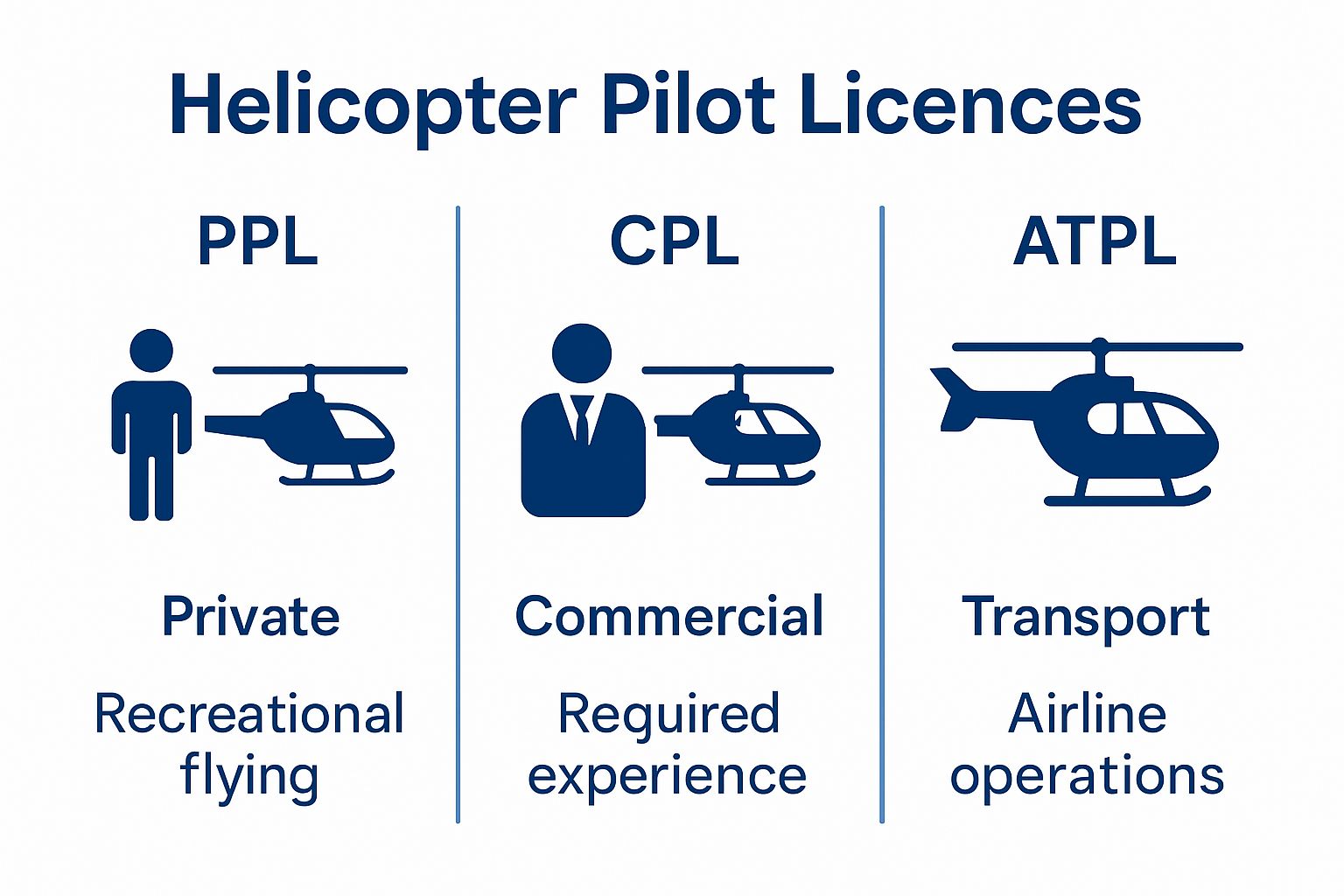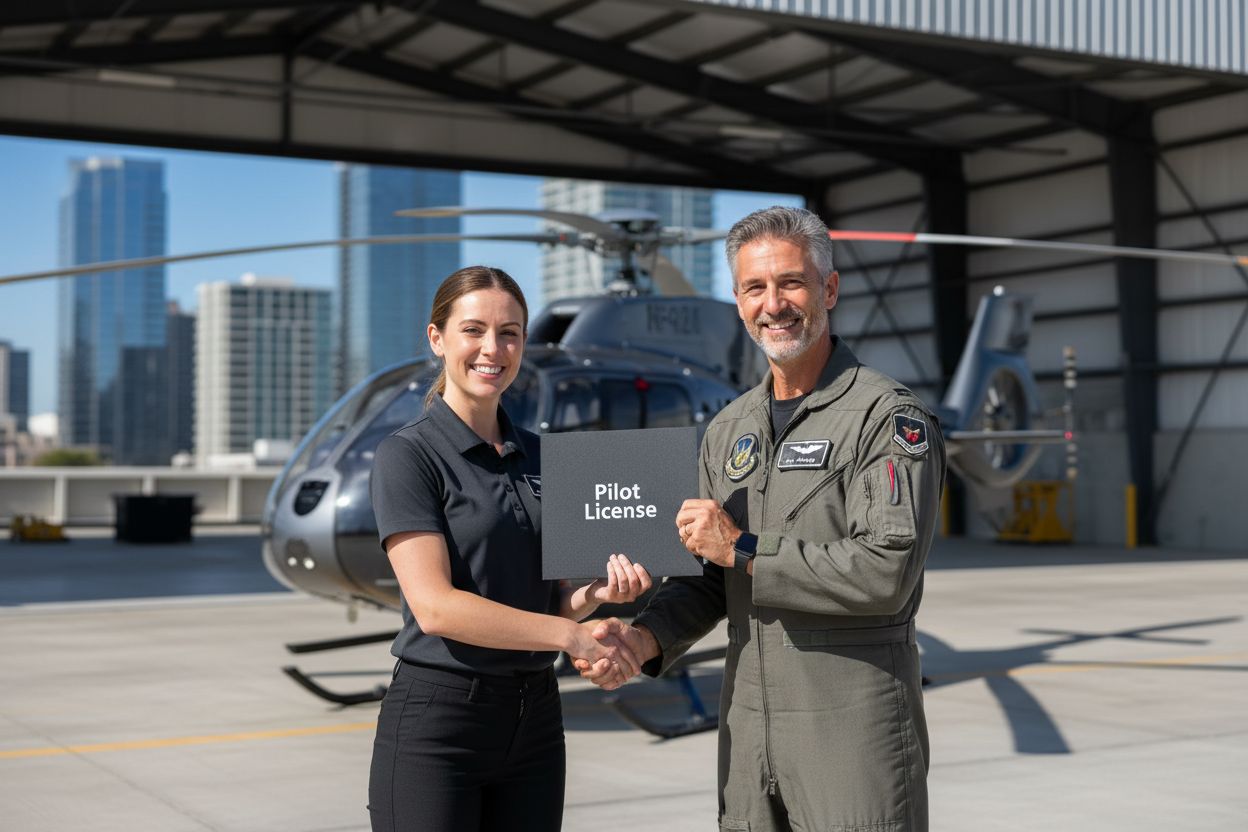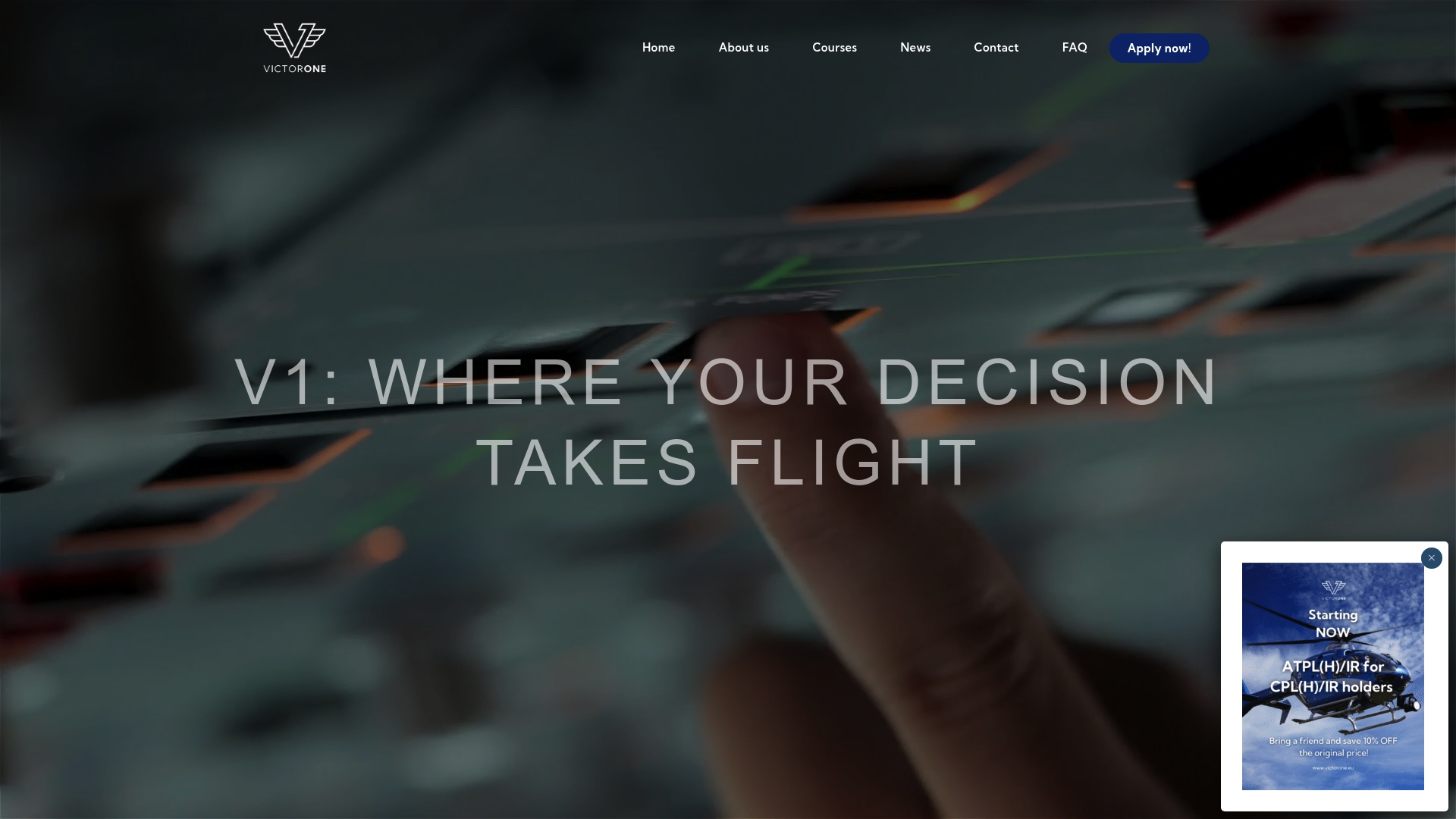Earning a helicopter pilot licence might sound like a badge for thrillseekers and adventurers, and for good reason. Helicopters are crucial lifelines in medical evacuation and rescue missions, with trained pilots providing help where ambulances simply cannot reach. Most people think getting this licence is about flying for fun or scenic tours, but the truth is far more compelling. These licences unlock not only unique career paths but also serve as the backbone of some of the most critical, life-saving operations across the globe.
Table of Contents
- What Is A Helicopter Pilot Licence And Its Purpose?
- The Importance Of Helicopter Pilot Licences In Aviation
- Key Requirements And Training For Helicopter Pilot Licences
- Real-World Applications Of A Helicopter Pilot Licence
- The Future Of Helicopter Pilot Licences And Career Opportunities
Quick Summary
| Takeaway | Explanation |
|---|---|
| Helicopter licences ensure safety compliance. | These licences mandate rigorous training that prepares pilots to handle complex flight scenarios, enhancing aviation safety standards. |
| Licences open diverse career opportunities. | Helicopter pilots can work in critical sectors like emergency services, industrial operations, and government roles, leveraging their skills. |
| Continuous learning is essential for pilots. | Pilots must regularly update their skills and knowledge through ongoing training and recertification to maintain operational competence. |
| Technological advancements are transforming training. | Innovations like virtual reality simulators and AI tools are revolutionising how pilots learn and maintain their flying abilities. |
| Emerging careers demand new skills. | As the aviation landscape evolves, pilots need to adapt to new technologies and operational standards for future opportunities. |
What Is a Helicopter Pilot Licence and Its Purpose?
A helicopter pilot licence represents an official certification that authorises an individual to legally operate rotary-wing aircraft, demonstrating comprehensive skills, theoretical knowledge, and practical proficiency required for safe aerial navigation. This specialised credential goes far beyond a simple permission document, serving as a rigorous validation of a pilot’s competence and understanding of complex aviation systems.
The Legal Framework of Helicopter Licensing
The helicopter pilot licence is a regulated document issued by aviation authorities like the European Union Aviation Safety Agency (EASA), which establishes strict standards for pilot training and operational capabilities. Research from the International Civil Aviation Organization indicates that these licences are critical for maintaining global aviation safety standards.
Key aspects of the helicopter pilot licence include:
- Demonstrating medical fitness for flight operations
- Proving theoretical knowledge across multiple aviation disciplines
- Completing mandated practical flight training hours
- Successfully passing both written and practical examinations
Purpose and Professional Significance
Beyond personal achievement, a helicopter pilot licence opens doors to diverse professional opportunities. Helicopter pilots play crucial roles in multiple sectors, including emergency medical services, search and rescue operations, commercial transportation, and industrial support like offshore oil rig logistics. Read more about professional helicopter pilot career paths to understand the breadth of potential career trajectories.
The licence serves multiple critical functions:
- Legal authorisation to operate rotary-wing aircraft
- Professional credential for commercial and private flying
- Verification of technical competence and safety standards
- Gateway to advanced aviation certifications and specialisations
Obtaining a helicopter pilot licence requires dedication, substantial financial investment, and commitment to continuous learning. Aspiring pilots must navigate complex training programmes, demonstrate exceptional technical skills, and maintain rigorous safety standards throughout their professional journey.
The Importance of Helicopter Pilot Licences in Aviation
Helicopter pilot licences represent a critical cornerstone of aviation safety, professional development, and operational excellence. These credentials are not merely bureaucratic documents but sophisticated instruments that ensure the highest standards of aerial proficiency, regulatory compliance, and technical expertise across diverse aviation domains.
Safety and Regulatory Compliance
Research from the Federal Aviation Administration highlights that comprehensive pilot licensing is fundamental to maintaining aviation safety standards. A helicopter pilot licence mandates rigorous training protocols that systematically prepare pilots to handle complex and potentially dangerous flight scenarios.
Key safety considerations include:
- Comprehensive risk assessment capabilities
- Advanced emergency response training
- Systematic understanding of aircraft mechanical systems
- Psychological preparedness for high-stress environments
Professional Advancement and Career Opportunities
Beyond safety, helicopter pilot licences unlock substantial professional pathways across multiple industries. Helicopter pilots are essential personnel in critical sectors such as emergency medical services, law enforcement, offshore industrial operations, and humanitarian missions. Learn more about helicopter pilot career pathways to understand the diverse opportunities available.
Professional sectors leveraging helicopter expertise include:
- Emergency medical transportation
- Search and rescue operations
- Military and defence services
- Aerial surveying and environmental monitoring
- Commercial transportation and logistics
Continuous Professional Development
A helicopter pilot licence is not a static credential but a dynamic qualification requiring continuous learning and periodic recertification. Pilots must consistently demonstrate their skills, update their knowledge base, and adapt to evolving technological and regulatory landscapes. This commitment ensures that helicopter pilots remain at the forefront of aviation safety and operational excellence, maintaining the highest standards of professional competence throughout their careers.
Key Requirements and Training for Helicopter Pilot Licences
Obtaining a helicopter pilot licence involves a comprehensive and structured approach that combines rigorous theoretical education, practical flight training, and stringent medical assessments. The process demands exceptional dedication, technical aptitude, and a systematic approach to learning complex aviation principles and operational skills.
Educational and Medical Prerequisites
Research from the European Union Aviation Safety Agency establishes clear guidelines for aspiring helicopter pilots. Candidates must meet specific educational and medical standards to commence their professional training journey. Minimum age requirements typically start at 17 years for private licences and 18 years for commercial certifications.
Key medical and educational requirements include:
- Possession of a valid Class 1 or Class 2 medical certificate
- Minimum educational qualification of secondary school completion
- Proficiency in English language communication
- Physical fitness demonstrating cardiovascular and neurological health
Comprehensive Training Framework
Helicopter pilot training encompasses both theoretical knowledge and practical flight experience. Learn more about pilot training pathways to understand the comprehensive journey. The training typically involves multiple stages, including ground school education, simulator training, and actual flight hours under professional supervision.
Training components typically include:
- Aerodynamics and helicopter systems understanding
- Navigation and meteorological knowledge
- Flight mechanics and operational procedures
- Advanced emergency response techniques
Licence Progression and Specialisation
Helicopter pilot licences are structured in progressive stages, allowing pilots to expand their qualifications and operational capabilities.
 Initial Private Pilot Licence (PPL) serves as the foundational certification, with subsequent commercial and professional ratings enabling more complex and specialised flying roles. Continuous learning, periodic skill assessments, and ongoing medical evaluations ensure that helicopter pilots maintain the highest standards of professional competence throughout their careers.
Initial Private Pilot Licence (PPL) serves as the foundational certification, with subsequent commercial and professional ratings enabling more complex and specialised flying roles. Continuous learning, periodic skill assessments, and ongoing medical evaluations ensure that helicopter pilots maintain the highest standards of professional competence throughout their careers.

Real-World Applications of a Helicopter Pilot Licence
Helicopter pilot licences unlock an extraordinary range of professional opportunities across multiple critical sectors, transforming technical skills into life-saving and economically significant services. These versatile credentials enable pilots to navigate complex operational environments where traditional ground transportation proves inefficient or impossible.
Emergency and Critical Services
Research from the International Helicopter Safety Foundation demonstrates the pivotal role helicopter pilots play in emergency response systems. Helicopters are crucial lifelines in medical evacuation, search and rescue, and disaster relief operations, providing rapid transportation in challenging terrain or during time-sensitive medical emergencies.
Key emergency service applications include:
- Emergency medical transportation
- Search and rescue missions
- Wildfire detection and firefighting support
- Disaster relief and humanitarian aid delivery
- Critical infrastructure inspection and maintenance
Industrial and Commercial Applications
Beyond emergency services, helicopter pilots provide essential support across diverse industrial sectors. Explore detailed career opportunities for helicopter pilots to understand the breadth of professional potential. From offshore oil platform logistics to environmental monitoring, helicopter pilots are integral to complex operational requirements.
Industrial sectors leveraging helicopter expertise include:
- Offshore energy exploration and support
- Aerial geological and environmental surveying
- Pipeline and power line infrastructure inspection
- Agricultural crop monitoring and management
- Media and cinematography aerial photography
Government and Military Operations
Government agencies and military organisations rely extensively on helicopter pilots for specialised missions requiring exceptional skill, precision, and adaptability.
The following table summarises the primary application sectors for helicopter pilots and highlights the distinct professional activities associated with each sector.
| Sector | Example Roles | Distinct Activities |
|---|---|---|
| Emergency Services | Air ambulance, Rescue pilot | Medical evacuation, Search and rescue, Disaster relief |
| Industrial/Commercial | Offshore transport, Media, Survey | Oil rig logistics, Aerial photography, Environmental monitoring |
| Government/Military | Police, Border patrol, Defence | Law enforcement, Border surveillance, Military operations |
| Agriculture | Crop management, Support pilot | Aerial crop monitoring, Precision agriculture |
| Infrastructure | Inspection, Survey | Powerline inspection, Pipeline monitoring |
The Future of Helicopter Pilot Licences and Career Opportunities
The helicopter pilot profession is experiencing unprecedented transformation, driven by technological innovations, evolving industry demands, and emerging global challenges. As aviation continues to adapt, helicopter pilot licences are becoming increasingly sophisticated, reflecting the complex operational landscape of modern aerial transportation and services.
Technological Advancements and Training Evolution
Research from the Boeing Future of Flight report indicates significant technological disruptions in aviation training and operational methodologies. Digital simulation technologies and advanced training platforms are revolutionising how helicopter pilots acquire and maintain their professional skills, creating more immersive and efficient learning experiences.
Key technological developments include:
- Advanced virtual reality flight simulators
- Artificial intelligence-enhanced training modules
- Sophisticated data analytics for performance tracking
- Augmented reality navigation assistance systems
Emerging Career Landscapes
The helicopter pilot career ecosystem is expanding beyond traditional roles, offering increasingly diverse and specialised opportunities. Explore comprehensive aviation career pathways to understand the breadth of potential professional trajectories. Emerging sectors are creating novel requirements for helicopter pilots, demanding versatility, technological proficiency, and adaptive skill sets.
Emerging career opportunities include:
- Autonomous and remotely piloted helicopter operations
- Urban air mobility and transportation services
- Advanced environmental monitoring and climate research
- Precision agricultural management
- Renewable energy infrastructure support
Regulatory and Professional Development Trends
Future helicopter pilot licences will likely incorporate more comprehensive international standards, emphasising continuous professional development, technological competence, and adaptability. Aviation regulatory bodies are increasingly focusing on creating flexible licensing frameworks that accommodate rapid technological changes while maintaining stringent safety standards. This approach ensures that helicopter pilots remain at the forefront of technological innovation, capable of navigating complex operational environments with exceptional skill and professionalism.
Take the Next Step Toward Your Helicopter Pilot Licence
Are you eager to transform your understanding of helicopter pilot licences into real-world qualifications? Many aspiring pilots struggle with mastering complex regulatory requirements, managing the cost and time commitments of training, and finding a trusted source for EASA-approved education. With so much at stake, it is essential to have flexible, high-quality online support to guide you through theoretical knowledge, exam preparation and licensing progression.

At VictorOne Academy, you will find structured, fully online EASA helicopter licence courses designed for international students. Our expertise addresses the exact pain points highlighted in this article—comprehensive digital materials, interactive question banks and dedicated support to help you succeed, wherever you are. If you are ready to progress and achieve your aviation ambitions, visit VictorOne.eu or browse our aircraft training options to start your journey today. Do not wait—your future as a certified helicopter pilot begins with a single step.
Frequently Asked Questions
What are the essential requirements to obtain a helicopter pilot licence?
To obtain a helicopter pilot licence, you need to meet educational and medical standards, including holding a valid medical certificate and completing secondary education. Start by enrolling in a recognised helicopter training programme that covers both theoretical and practical components.
How long does it take to complete the training for a helicopter pilot licence?
The training for a helicopter pilot licence typically takes several months to over a year, depending on how frequently you fly and your previous experience. Dedicate consistent practice and study time each week to help accelerate the process and maximise learning outcomes.
What types of helicopter pilot licences are available?
There are several types of helicopter pilot licences, including the Private Pilot Licence (PPL) and Commercial Pilot Licence (CPL). Assess your goals and start with a PPL if you aim to fly privately, or pursue a CPL for commercial opportunities.
To help clarify the different types of helicopter pilot licences and what each one allows, the table below compares their key characteristics.
| Licence Type | Minimum Age | Main Usage | Privileges and Limitations |
|---|---|---|---|
| Private Pilot Licence (PPL) | 17 | Recreational/private | Fly privately; not for commercial remuneration |
| Commercial Pilot Licence (CPL) | 18 | Professional/commercial | Fly for hire; eligible for a range of paid roles |
| Instrument Rating | Varies | Specialisation | Fly in low-visibility using instruments |
| Night Rating | Varies | Specialisation | Permits legal night flying |
| Advanced/Special Ratings | Varies | Specialisation | Enables specific tasks (e.g. instructing, rescue) |
How can I progress my helicopter pilot licence to specialised ratings?
To progress to specialised ratings, such as instrument or night flying, you will need additional training and practical flight hours. Plan to complete these qualifications alongside your regular flying practice, typically requiring an extra 10-20 flight hours for each rating.
What is the importance of continuous professional development for helicopter pilots?
Continuous professional development is vital for helicopter pilots to maintain their skills and stay updated with evolving regulations and technologies. Commit to regular training sessions and self-study to keep your knowledge current and ensure top-notch flying competency.
How does a helicopter pilot licence contribute to career advancement?
A helicopter pilot licence opens doors to various career opportunities across emergency services, industrial operations, and government roles. Explore diverse industries actively seeking qualified pilots to enhance your career trajectory.

